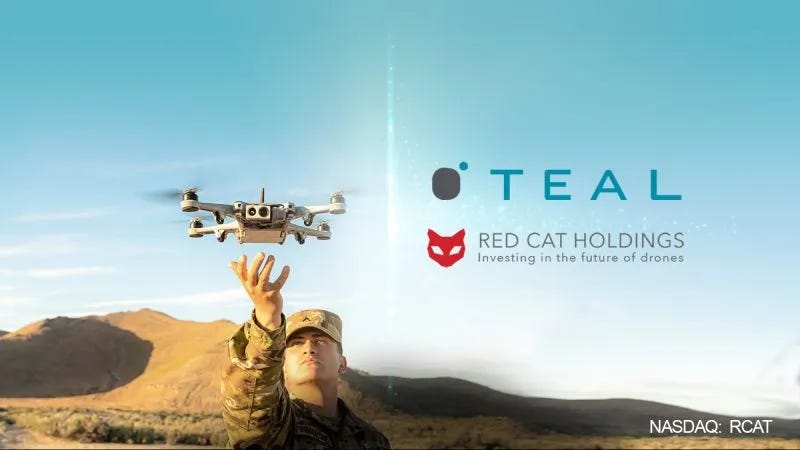Red Cat's Perfect Storm: Is This Drone Stock Cleared for Takeoff?
A seismic shift is underway in the global drone industry, and Red Cat Holdings (RCAT) is positioned directly at its epicenter. The U.S. government recently announced an easing of its drone export policy, a move explicitly designed to bolster the competitiveness of American manufacturers abroad. For a company like Red Cat, this isn't just a tailwind; it's a potential gale force.
This policy change arrives amidst a flurry of company-specific and geopolitical catalysts that have ignited investor interest, sending the stock on a volatile run. But with this surge comes a critical debate: Is Red Cat a speculative, high-risk bet fueled by hype, or is it a ground-floor opportunity to invest in a future leader of a multi-billion dollar industry?
Let's break down the powerful bull and bear cases for this polarizing stock.
The Bull Case: A Convergence of Unprecedented Catalysts
Investors bullish on Red Cat are not just betting on a single company; they are betting on a trio of powerful, interlocking trends that could fundamentally reshape the drone market.
The Geopolitical Gold Rush: From the battlefields of Ukraine to rising tensions along the NATO border, the strategic importance of small, agile, and secure drones has never been clearer. The recent U.S. policy shift to ease exports directly empowers companies like Red Cat to meet this surging international demand. This isn't just about selling more hardware; it's about integrating American technology into the defense infrastructure of its allies.
The NATO Fast-Track: In a major validation of its technology, Red Cat’s Black Widow drone system was recently approved for the NATO Support and Procurement Agency (NSPA) catalog. This is a game-changer. It effectively gives the company a "pre-approved" status, dramatically streamlining the procurement process for all 32 NATO member nations. This approval cuts through bureaucratic red tape, shortens sales cycles, and provides a level of credibility that money can't buy.
The DJI Endgame: Perhaps the most explosive catalyst is the potential ban of Chinese drone giant DJI from the U.S. market. Due to national security concerns, regulations could block new DJI equipment authorizations by the end of the year. Considering DJI currently holds an estimated 90% of the U.S. public-safety drone market, its removal would create a $1.6 billion vacuum.
Red Cat is actively preparing for this moment, reportedly developing a civilian version of its military-grade Black Widow drone. Capturing even a 10% share of the displaced DJI market would imply a revenue opportunity of approximately $160 million annually—a figure that would completely transform the company's financial landscape.
The Bear Case: Valuation and Execution Risk
Despite the powerful narrative, the risks are just as significant. Skeptics point to several red flags that caution against unbridled optimism.
A Valuation Priced for Perfection: Even with the massive potential, the stock trades at a very steep premium. Much of the upside from the NATO news and the potential DJI ban may already be priced in. The company is currently unprofitable, and its cash reserves have been boosted through equity dilution, a practice that can harm long-term shareholder value.
Fierce Competition: Red Cat is not the only player vying for this lucrative market. Well-established defense contractors and other agile drone startups are all competing for the same contracts and market share. The competitive landscape is fierce, and victory is not guaranteed.
Execution is Everything: A potential market opportunity is not the same as realized revenue. Red Cat must flawlessly execute on its strategy. This means rapidly scaling production of its new civilian drone, navigating complex government and international sales channels, and proving its products are superior to competitors in real-world scenarios. Any misstep in execution could see the opportunity slip through its fingers.
The Ground View: A Battle of Conviction
A look at social media platforms like X and Reddit reveals a deeply divided investor base. On one side, you have a vocal community of bulls, energized by the powerful macro story. They see a clear path to exponential growth and view any dip as a buying opportunity.
On the other side, cautious investors and skeptics are sounding the alarm on the stock's "expensive" fundamentals, cash burn, and speculative nature. They argue that the stock is a gamble on future events, not a sound investment based on current financial health.
Conclusion: A High-Risk, High-Reward Bet on the Future
Red Cat is not a stock for the faint of heart. It is the epitome of a high-risk, high-reward investment. The bull case is compelling, built on a rare convergence of favorable government policy, massive geopolitical demand, and the potential removal of its largest competitor.
However, the company is walking a tightrope. Its valuation demands near-perfect execution, and the road ahead is fraught with competitive and financial risks. An investment in Red Cat today is less about its current balance sheet and more about a strong conviction in its ability to seize the monumental opportunity that lies before it. Whether it soars to new heights or succumbs to the pressure will depend entirely on its ability to turn powerful potential into profitable reality.


